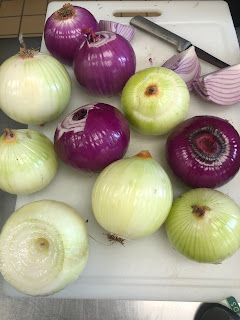Is all Yogurt created equal?
It was a big day for
me in the Extension office. I got my first nutrition question! A man had come
in looking for an engineer to consult him about a wall that had fallen down. I
assured him that I in no way was an engineer but knew quite a bit about food
and nutrition. “So you can tell me what to eat?” was his response but then as
he was leaving the office he thought of a question that had puzzled him.
Yogurt. He said that he had been to the grocery store and was overwhelmed with
the options and he simply wanted to know what the healthiest choice was. This
got me to thinking that the yogurt section has really expanded over the last
couple of years. Where the hardest choice used to be vanilla or strawberry,
consumers now have to navigate Greek, Whipped, European, Icelandic, Full Fat,
Non-Fat, Dairy Free, Kefir, Yogurt Drinks etc. Today we are going to take a
your of the yogurt section at the grocery store to give you confidence in
choosing the best yogurt for you!
First let’s cover the
basis. Yogurt is milk that has been bacterially fermented. Some of the bacteria
present in yogurt are called “probiotics”. This is the same bacteria that is
naturally found in our intestines and that helps us digest our foods. Yogurt is
a dairy product as well. The Dietary Guidelines for Americans recommends that
we 3 cups of low fat dairy each day. So yogurt is most definitely a great way
to hit your dairy recommendation and feed your intestines some healthy
bacteria. So what kind should you
choose? Let’s look at different kinds of yogurt.
Whole milk, Low fat or Non-Fat yogurt is the first decision
you are faced with. The best way to navigate this decision is to read the food
label. This will shed light on the amount of fat and sugar present in the
yogurt. Traditional yogurt is creamy in texture because it has not been
unstrained so it contains more whey than other yogurts.
Greek Yogurt is similarly made as regular yogurt but is
strained to remove more whey and lactose (the natural sugar present in milk).
What is left is a thicker yogurt that is higher in protein, less sugar, but
higher in fat. If you are going to choose Greek yogurt, choose a plain low fat
variety. Use your own method of sweeting with honey or fresh fruit. Plain Greek
yogurt can also be used in place of sour cream as a healthier alternative. You
can also swap half the butter with Greek yogurt for healthier baked goods.
Icelandic is even thicker than Greek yogurt! Also known as
skyr, it is one of the highest protein packed yogurt option but at a higher
cost because it takes 4 cups of milk to make 1 cup of yogurt this way.
Kefir is a fermented milk drink. It is thicker than normal
milk and due to fermentation can even feel slightly carbonated. It is available
in both full fat and low fat options and is a great addition to smoothies or a
morning breakfast routine for dairy on the go.
So what do you choose? If we go back to the Dietary
Guideline recommendations, low fat yogurt options are going to be a healthy
choice. Try and stick to plain yogurt options so that way you can maintain
control the sugar that is being added. If you are looking at increasing the
protein in your diet, Greek or Icelandic yogurt options are going to be a
better choice due to the increased protein due to the straining process.
Hopefully you are now feeling a little more confident and a
lot more cultured….
References:



Comments
Post a Comment